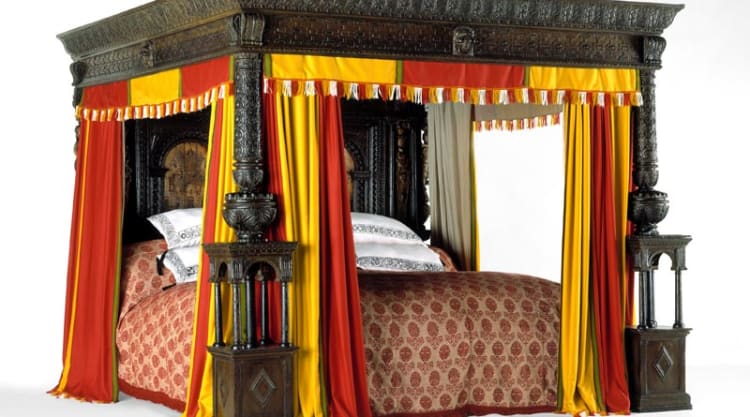
Our Top Ten Facts About the Great Bed of Ware
Posted 30 November 2009

Oh yeah, the Great Bed of Ware. This is possibly one of our favourite beds of all time here at The Sleep Room. In its day it was the ultimate in luxury beds, but...
Oh yeah, the Great Bed of Ware. This is possibly one of our favourite beds of all time here at The Sleep Room. In its day it was the ultimate in luxury beds, but this one has stayed the course.
- It was built by Hertfordshire carpenter Jonas Fosbrooke in around 1590. He certainly had his work cut out - it's made of oak, measures ten by eleven feet and is decorated with elaborate carved marquetry
- Originally, it would have been brightly painted. If you look closely you can still see traces of the original colours on the figures carved on the bed-head.
- It's said that it can sleep over fifteen people at once. We are not sure that we recommend this for a truly restful night
- The bed started off in situ at the White Hart Inn in Ware, Hertfordshire (where we like to imagine they advertised 'Football Shown Here! Modern Beds !) on a little chalk board outside. But by the 1800s it was moved to the Saracen's Head in the same town. We're not sure why, but we're really glad we didn't have to do the lifting with that one.
- The bed moved again in 1870 when a Mr William Henry Teale bought it and - somewhat whimsically - decided to pop it in his pleasure garden at the Rye House.
- In 1931 the Victoria & Albert Museum bought it, and there it remains. Go and see it! But try try try not get in … you may never get out.
- Sir Toby Belch refers to the bed in Shakespeare's Twelfth Night, mentioning a bed sheet 'big enough for the bed of Ware'.
- Playwright Ben Jonson called it 'the great bed at Ware' in a play in 1609, and it is also mentioned in George Gordon Byron's Don Juan.
- Visitors often carved their initials on the bed or applied red wax seals, which are still visible on the bedposts and headboard today. We cannot stress enough that these were visitors to the Hertfordshire inns, and NOT visitors to the Victoria & Albert museum.
- We very much wish that this bed could talk. Oh, the stories.

Oh yeah, the Great Bed of Ware. This is possibly one of our favourite beds of all time here at The Sleep Room. In its day it was the ultimate in luxury beds, but...
Oh yeah, the Great Bed of Ware. This is possibly one of our favourite beds of all time here at The Sleep Room. In its day it was the ultimate in luxury beds, but this one has stayed the course.
- It was built by Hertfordshire carpenter Jonas Fosbrooke in around 1590. He certainly had his work cut out - it's made of oak, measures ten by eleven feet and is decorated with elaborate carved marquetry
- Originally, it would have been brightly painted. If you look closely you can still see traces of the original colours on the figures carved on the bed-head.
- It's said that it can sleep over fifteen people at once. We are not sure that we recommend this for a truly restful night
- The bed started off in situ at the White Hart Inn in Ware, Hertfordshire (where we like to imagine they advertised 'Football Shown Here! Modern Beds !) on a little chalk board outside. But by the 1800s it was moved to the Saracen's Head in the same town. We're not sure why, but we're really glad we didn't have to do the lifting with that one.
- The bed moved again in 1870 when a Mr William Henry Teale bought it and - somewhat whimsically - decided to pop it in his pleasure garden at the Rye House.
- In 1931 the Victoria & Albert Museum bought it, and there it remains. Go and see it! But try try try not get in … you may never get out.
- Sir Toby Belch refers to the bed in Shakespeare's Twelfth Night, mentioning a bed sheet 'big enough for the bed of Ware'.
- Playwright Ben Jonson called it 'the great bed at Ware' in a play in 1609, and it is also mentioned in George Gordon Byron's Don Juan.
- Visitors often carved their initials on the bed or applied red wax seals, which are still visible on the bedposts and headboard today. We cannot stress enough that these were visitors to the Hertfordshire inns, and NOT visitors to the Victoria & Albert museum.
- We very much wish that this bed could talk. Oh, the stories.